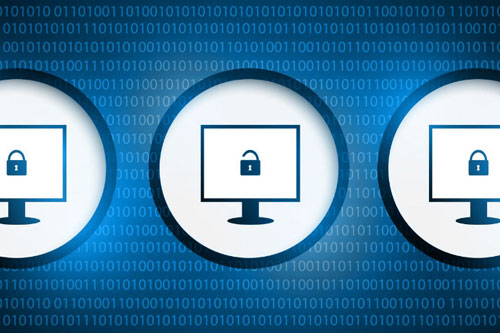You’re accessing archived content
This is archived content from the UIT website. Information may be outdated, and links may no longer function. Please contact stratcomm@it.utah.edu if you have any questions about archived content.
What to do when an abuser uses technology against you
Note: October is Cybersecurity Awareness Month (CSAM) and Domestic Violence Awareness Month (DVAM). This article highlights how technology can be misused, and how being cyber smart can help protect people from abusers and other bad actors. For more information about how the U is raising awareness during DVAM, please access this article by the Center for Student Wellness.
____
Technological innovations have changed our lives — in many ways for the better. The connections and convenience that technology offers and that most people enjoy as part of their daily lives, however, also make it easier for abusers and criminals to threaten, harm, and steal from others. Unfortunately, the University of Utah’s Information Security Office (ISO), law enforcement organizations, and victim advocates see this all too often.
A 2014 Safety Net Project survey found that of the victim services provider organizations they asked, “97% indicated that victims who seek their services are being harassed, monitored, and threatened by offenders misusing technology.”
Additionally, the survey found:
- 79 percent reported that abusers monitor survivors’ social media accounts
- 96 percent reported that abusers harass their victims using text messages
- 57 percent reported that abusers use social media to impersonate others
- 67 percent reported that abusers track or stalk people through social media
Those statistics and many more are startling, yet they expose the misuse of technology to harm, harass, impersonate, stalk, and surveil people unknowingly. With this knowledge, however, we can better evaluate how we use technology and take steps to protect ourselves and those around us.
For example, social media use has increased this year. That, and the fact that many of us have faced some level of quarantine related to COVID-19, means that we are probably sharing more information online than in the past. We may be actively posting about our likes, dislikes, habits, routines, and family and friends on a daily basis. All this information is a goldmine for those who would threaten or harm us, or steal our identity.
In fact, the Safety Net Project survey indicated that offenders most often used social media, text messaging, and email to monitor and disrupt their targets, because those are the platforms survivors use most.
“The technology itself does not necessarily increase or enhance abuse, but because the technology provides access to the survivor (or her/his information), it is the place where abuse occurs,” the report said.
In light of this information, we’ve compiled some tips to help you protect your identity and privacy from abusers and other bad actors. Once you’ve taken steps to protect yourself online, help those around you. People you know may need help but are unsure where to turn or are too intimidated to ask for it.
- Review the privacy settings on your social media platforms. Who can see what you post?
- While we love to share with family and friends details about our travels or vacation pictures, we should wait to post about them until returning home and never geotag a social post. According to Consumer Reports, insurance and home security experts say “instabragging,” or social media posts that indicate you are away from home, could make you a target for criminals and get you in trouble with your home insurer.
- Use multifactor authentication (MFA), sometimes called two-factor authentication (2FA), whenever possible. This is the same as using Duo Security on campus for your university account, except for your personal accounts. While a strong password is the right step toward being safer online, it is just one step. MFA/2FA adds another layer to keep people from stealing your identity or invading your privacy.
- Enable a password, or facial or fingerprint recognition, on your phone or device to keep it locked while not in use. It doesn’t take long for a person to install tracking software, or change settings on your phone, that allow you to be tracked. It also helps to prevent the theft of your data if your device is stolen.
- Keep your passwords safe, just like you would your wallet or banking information. Sharing your passwords, reusing them across websites, or using easy-to-guess passwords (e.g., your pet’s name, especially if you post about your pet online) makes you extremely vulnerable.
- Keep your security questions up to date on the different sites and apps that you use. These questions are used to identify you when you can’t access your account. Like passwords, your security answers should not be predictable. If they are, a person can pretend to be you, reset your password, and lock you out of your accounts (e.g., bank, cellphone provider, internet service provider, email, and even your account with the local electrical utility company).
Resources
If you or someone you know is the victim of stalking, harassment, or abuse, help is available.
- For imminent harm or to report a crime, contact the University of Utah Department
of Public Safety.
- 911 or 801-585-COPS (2677)
- https://safeu.utah.edu/how-do-i-report/
- Victim-Survivor Advocacy, Center for Student Wellness
- For a comprehensive list of all safety-related information, reporting and support resources, training and more at the University of Utah, please visit the SafeU website.
- Employee Assistance Program
- 801-587-9319
- https://www.hr.utah.edu/benefits/eap.php
- For cybersecurity incidents and emergencies, contact the Information Security Office
(ISO).
- 801-587-1925
- soc@utah.edu
- For incidents regarding privacy, contact the University of Utah Privacy Office:
- For more information about technology in the context of intimate partner violence, sexual assault, and violence against women, visit https://www.techsafety.org/
2020 Cybersecurity Awareness Month
 Creating a cybersecure workspace — at home
Creating a cybersecure workspace — at home
 Why so many phishing attacks succeed
Why so many phishing attacks succeed
 Meet the computer forensics experts who investigate the U's cybersecurity incidents
Meet the computer forensics experts who investigate the U's cybersecurity incidents
 8 simple tips to improve your online safety and security
8 simple tips to improve your online safety and security
 Common scams — and how to spot them
Common scams — and how to spot them
 CSAM Scavenger Hunt
CSAM Scavenger Hunt
